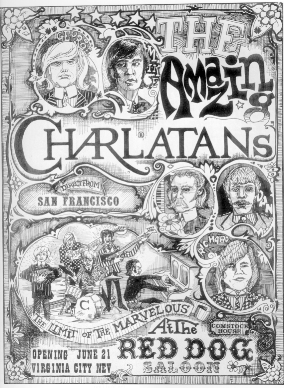
It is the dawn of 1964 and the artists of rock are about to turn the world on its ear. Michael Ferguson (piano player for The Charlatans) along with George Hunter (leader-The Charlatans) draw the first concert poster in the new mode (nicknamed “The Seed”). Musically the U.S. was about to be invaded by the British. The American response would unleash forces just as powerful. From that development came a new genre of art: the psychedelic rock poster. It is beyond the scope of this page to list all artists involved in this new genre. Below are some interesting bios on the "Big 5" in concert poster art (as they were affectionately called). Also, check the forum for in depth discussions about The Artists.
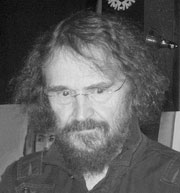
Stanley Mouse
(born Stanley George Miller – 1940- )
Born in Detroit, Stanley Miller became known as "Mouse" after illustrating countless notebooks with his signature rodent sketch. After an episode of graffiti mischief got him expelled from high school, he enrolled in Detroit's School for the Society of Arts and Crafts but found the courses uninspiring. Miller found an outlet for his creativity in pin-striping cars and airbrushing designs on posters and T-shirts while he traveled around the country with the hot-rod circuit. In 1963, he established his own corporation, Mouse Studios, producing a line of decals, posters and T-shirts. Mouse migrated to San Francisco in 1964, where he first met the artists associated with Family Dog, the organization producing dance concerts at the Avalon Ballroom. Mouse landed a job creating promotional posters for Family Dog. With collaborator Alton Kelley, Mouse experimented broadly with composition, lettering and imagery: Kelley came up with the ideas and Mouse executed the designs. Their work evolved into a characteristic style filled with visual puns that captured the playful, anything-goes spirit of Haight-Ashbury. Mouse later replaced poster artist Wes Wilson at the Family Dog and, beginning in June of 1966 and in collaboration with Alton Kelley, helped to establish the psychedelic style of expression under the name Mouse Studios. This creative team produced a number of striking concert posters over the next two years, incorporating human and commercial images that resonated in the hippie culture, one of the most famous featuring ZigZag cigarette rolling papers and another, the Grateful Dead skull and roses motif. When the demand for rock posters dropped off in the 1970s, Mouse and Kelley moved on to design rock T-shirts and album covers. Their cover for Steve Miller's album, Book of Dreams, won a Grammy Award in 1977. Although production was limited, Mouse and Kelley's 1978 Blue Rose poster, created to commemorate the closing of the Winterland Arena, is considered a classic from this decade. Mouse currently lives with his wife in Sonoma, California. He has made a career licensing the commercial rights to his rock designs and is establishing his reputation as a fine arts painter.
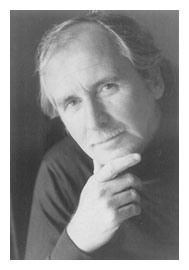
Alton Kelley (1940-2008)
Born in Houlton, Maine, Alton Kelley had an early childhood fascination with anything mechanical and came to love cars, motorcycles and hot rods. He studied industrial design in college, but quit school and moved West in 1964. As one of several hippies inhabiting a Victorian house in the Haight-Ashbury district, he became a founding member of the Family Dog, a collective of activist, enterprising hippies who eventually staged events at the Avalon Ballroom. Despite minimal drafting and art experience, Kelley handled the promotion for the events of the Family Dog, drawing posters and handbills. He soon met up with Stanley Mouse, and their association nurtured Kelley's success as an artist. Kelley had a natural talent for collage and a keen eye for culling and combining imagery and styles from diverse sources. Teamed with Mouse's drafting skill, collaborations became increasingly sophisticated, yet irreverent. Kelley also occasionally teamed with Rick Griffin, claiming that a positive sense of rivalry among the poster artists was an incentive rather than a competition. Kelley always worked by hand, producing posters and other print graphics for a wide array of entertainment-oriented clients. With Mouse, he published their biography, Mouse and Kelley, in 1979.
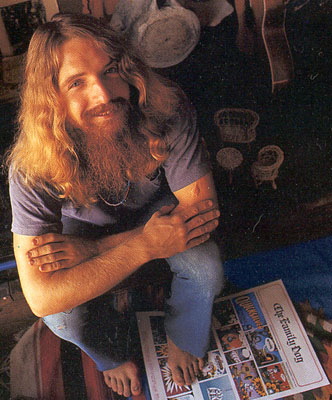
RickGriffin (1944-1991)
Born near Palo Verde, California, Rick Griffin grew up in the surfing culture of Southern California, a milieu which had a profound influence on his art. After high school, he worked on the staff of Surfer magazine and created the best-known surfing cartoon character of the time, Murphy. In Los Angeles, Griffin met the Jook Savages, a group of artist-musicians, and took part in writer Ken Kesey's "Watts Acid Test." Griffin's first rock poster was for the Jook Savages, and when organizers for the "Human Be-In" saw the poster in San Francisco, they asked him to do a poster for their own event in January of 1967. Chet Helms of the Family Dog saw Griffin's work too, and asked him to design posters for the dance parties at the Avalon Ballroom. Griffin took his early influences from advertising and from the counterculture. Combining eclectic typefaces and decorative borders with brilliant colors, Griffin's compositions were complex without being illegible. He introduced diverse, often startling, objects into his posters, creating visual-verbal puns and playful references to pop culture. A perfectionist, Griffin often applied dozens of overlays and redrew lettering again and again until he was satisfied. In the early 1970s, Griffin became a born-again Christian and religious themes dominated his work. These later works are powerful and bizarre, concerned with ideas of mortality and continuity. Among his last posters were those produced for The Grateful Dead, which illustrate Griffin's vivid imagination and graphic skill. Griffin was killed in a motorcycle accident in 1991.
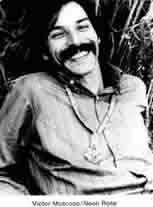
Victor Moscoso (1936 - )
Born in Spain, Victor Moscoso was the first of the rock poster artists with serious academic training and experience. After studying art at Cooper Union in New York City and at Yale University, he moved to San Francisco in 1959. There, he attended the San Francisco Art Institute, where he eventually became an instructor. At the dances at the Avalon Ballroom in San Francisco, Moscoso saw rock posters and decided that he could "make some money doing posters for those guys." In 1966, he began designing posters for the Family Dog and for the Avalon Ballroom. Under his own imprint, Neon Rose, he did a series for Matrix, a local nightspot. Moscoso's style is most notable for its visual intensity, which was obtained by manipulating form and color to create optical effects. Moscoso's use of contrasting colors and vibrating edges was influenced by painter Josef Albers, his teacher at Yale. Given Moscoso's sophistication, is it not surprising that he was the first of the rock poster artists to use photographic collage. He used clashing, vibrating colors and deliberately illegible psychedelic lettering to demand attention.
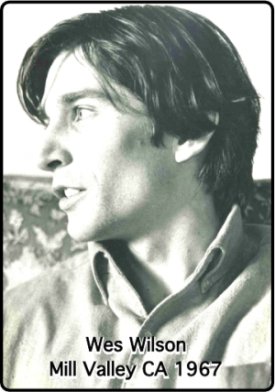
Wes Wilson (1937 - )
Wes Wilson attended San Francisco State University and was working at Contact Printing, a small San Francisco press, when his career as a psychedelic-poster artist took off. At Contact, Wilson did the layout and design for handbills that eventually established him as a poster designer. When the Avalon Ballroom and Bill Graham's Fillmore Auditorium began to hold weekly dance concerts, Wilson was called upon to design the posters. He created psychedelic posters from February 1966 to May 1967, when disputes over money severed his connection with Graham. Wilson's early work was unique, but by mid-1967 so many artists had copied his style that he was replaced with barely a ripple in the production process. Wilson pioneered the psychedelic rock poster. Intended for a particular audience, "one that was tuned in to the psychedelic experience," his art, and especially the exaggerated freehand lettering, emerged from Wilson's own involvement with that experience and the psychedelic art of light shows. His influential lettering was derived from Vienna Secessionist lettering he discovered in a University of California exhibition catalogue, and his experimentation with the form led to his recognizable pulsating pictures with undulating letters. Wilson moved his family to a farm in the Ozarks, from where he published a poster art news journal from 1991-95 and exhibited his sixties posters at the Springfield Art Museum in the early '90s.








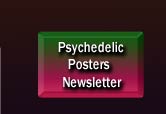
.jpg)















.jpg)





